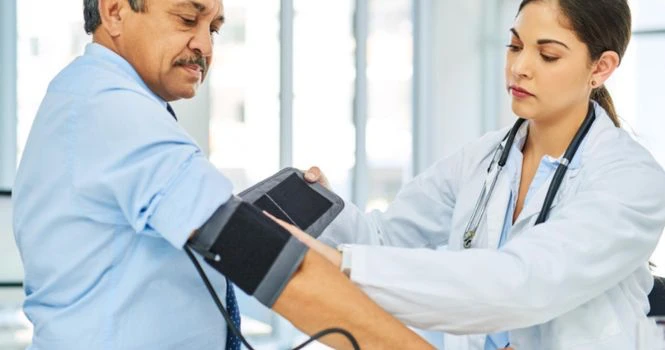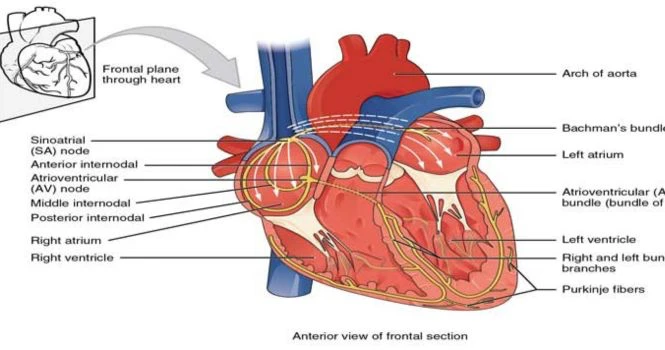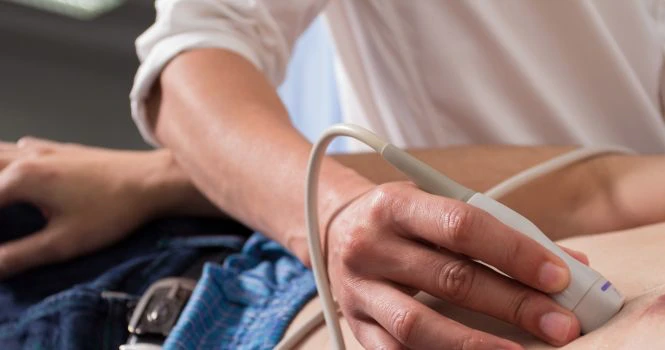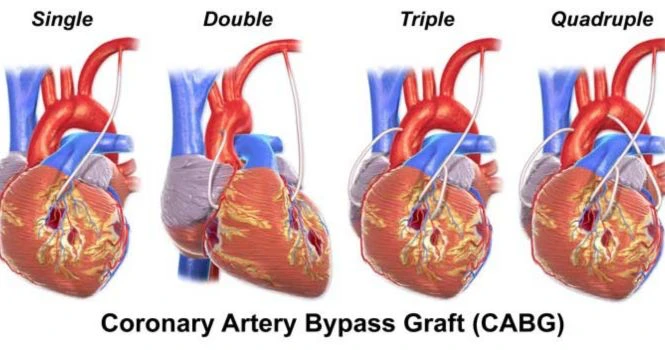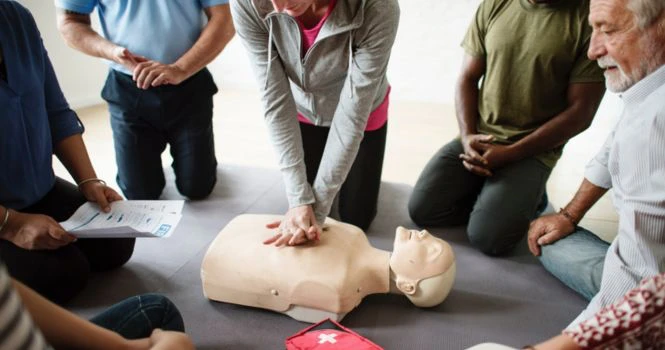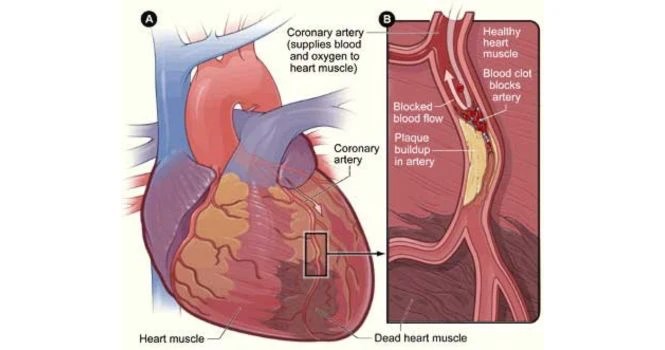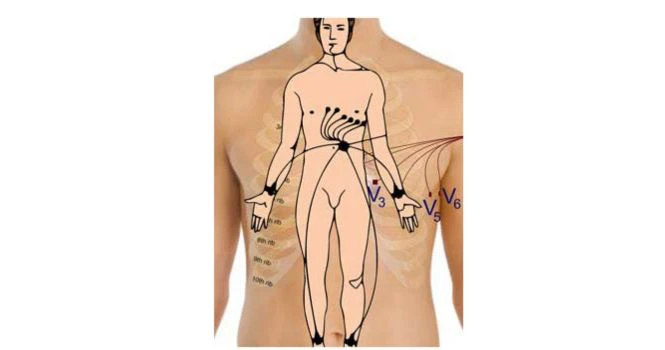High Blood Pressure Synonyms
High blood pressure is also called as
- Hypertension
- Benign Essential Hypertension
- HBP
- HTN
- High BP
What is Blood Pressure?
Blood Pressure is the force with which the blood is flowing in the blood vessels.
What is High Blood Pressure?
The force with which the blood flows through the walls of the arteries and when this force is consistently high as measured by a BP apparatus, then we call it High Blood Pressure or Hypertension. High blood pressure medical term is Hypertension.
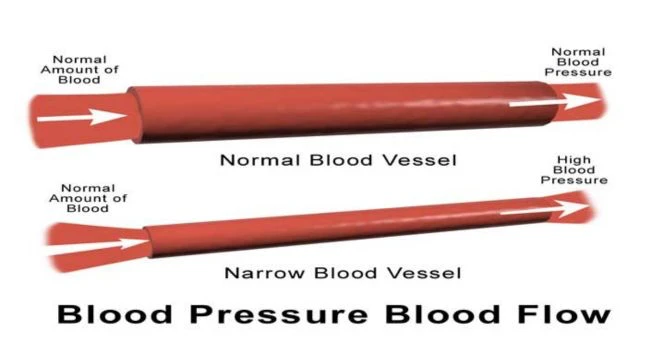
What are different types of High Blood Pressure?
- Primary Essential Hypertension (95%)
- Hypertension due to secondary causes(5%)
In Primary essential hypertension, 95% of patients who have high Blood pressure is due to complex interactions with multiple genetic and environmental factors. The other 5% of hypertensives are due to some secondary cause.
Causes of Secondary Hypertension:
- Sleep Apnea
- Drug related
- Chronic Kidney disease
- Primary aldosteronism
- Renovascular disease
- Long term treatment with corticosteroids, cushing syndrome, pheochromocytoma
- Coarctation of aorta
- Thyroid or Parathyroid disease
What is Normal Blood Pressure?
Normal blood pressure is always in a range, as it keeps going up and down during our daily activities.
Normal Blood Pressure is 120/80 mm of Hg, where mm of Hg is millimeters of Mercury, which is the standard unit of measurement of pressure.
- 120 is the Upper Systolic number
- 80 is the Diastolic number
Systolic range is 100 to140 (mm of Hg)
Diastolic range is 60 to 90 (mm of Hg)
Systolic Blood Pressure
Systolic Blood pressure indicates how much pressure the blood is exerting against the walls of the arteries, when the heart beats or contracts. For most people, it rises steadily with age, which implies Blood Pressure rises with age.
From age 40 years to 89 years, the risk of death for heart disease and stroke doubles for every 20 mm of Hg increase in systolic blood pressure.
Diastolic Blood Pressure
Diastolic blood pressure indicates how much pressure the blood is exerting against the walls of the arteries, when the heart is relaxing or resting between beats.
From age 40 years to 89 years, the risk of death for heart disease and stroke doubles for every 10 mm of Hg increase in diastolic blood pressure.
Blood Pressure Reading Chart
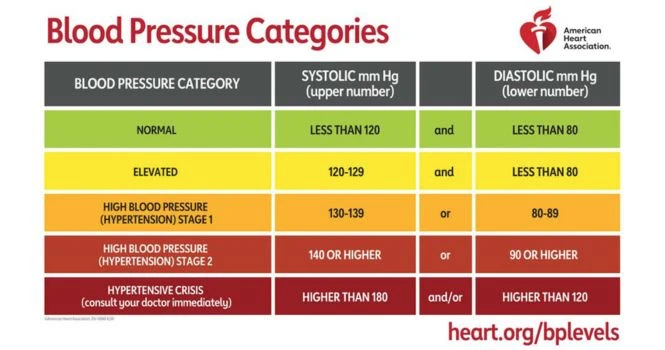
How to check your BP with automatic Digital BP recording machine at Home:
How is BP Measured?
We measure it at home with a Digital BP apparatus. The reading depends on how well you follow the instructions to measure it, which are mentioned in the video, which is embedded in this article.
Doctors and healthcare care professionals measure BP manually with mercury Sphygmomanometer, which is the Gold Standard for measuring blood pressure, in millimeters of Hg (It is written as Hg because, Hg derives from, “Hydrargyrum , meaning Liquid Silver, and hence Mercury has a chemical symbol – Hg)
Prevalence of High BP in the World
According to WHO Approximately 1 in 5 adults (21%) with hypertension have it under control and are a major cause of premature death.
One of the global targets for noncommunicable diseases is to reduce the prevalence of hypertension by 33% between 2010 and 2030.
Tracking of Blood Pressure
If blood pressure levels of individuals were followed up over a period of years from early childhood into adult life, then those individuals whose pressures were initially high in the distribution, would probably continue in the same “track” as adults.
In other words,
- low blood pressure levels tend to remain low, and
- high levels tend to become higher as individuals grow older.
This phenomenon of persistence of rank order of blood pressure has been described as “tracking
What is Hypertension Stage 1 ?
The stage where
- Systolic BP is between 130 to 139
- Diastolic BP is between 80 to 89
High Blood Pressure 140/90
This reading would be considered as Stage 2 Hypertension.
Hypertension stage 1 symptoms | How hypertension is diagnosed ?
High blood pressure usually has no symptoms, but few reported are headache, dizziness, syncope etc. But if not treated, it can damage the kidneys, heart and brain. We find that our blood pressure is in the higher range only by chance or when we consult a doctor for some other ailment. Hence, called the Silent Killer.
Your doctor would not diagnose you with high blood pressure if you have one or two high readings.
You would be asked to undergo repeated recordings in different times of the day and on different days and then the doctor would put you on treatment programs which involves making changes to your lifestyle and considering other factors, before putting you on antihypertensives medications.
As one gets older, the blood pressure rises and it’s very important that we get ourselves checked at regular intervals, to tackle this silent killer. Uncontrolled High Blood Pressure can lead to Stroke.
Your risk would increase if you are / have,
– Smoker
– Overweight
– Eating processed food which has high Salt Content
– Family history of high blood pressure
– Leading a sedentary lifestyle
– Drinking alcohol
– African or Caribbean descent
What is Hypertension Stage 2 ?
The stage where
- Systolic BP is 140 or higher
- Diastolic BP is 90 or higher
What is Hypertension Stage 3 ?
The stage where
- Systolic BP is higher than 180
- Diastolic BP is higher than 120
High Blood Pressure Reasons | Risk Factors for Hypertension
1. Non-modifiable risk factors
- AGE : Blood pressure rises with age in both sexes and the rise is greater in those with higher initial blood pressure. Some populations have now been identified whose mean blood pressure does not rise with age. These communities are for the most part primitive societies with calorie and often salt intakes at subsistence level. (the action or fact of maintaining or supporting oneself, especially at a minimal level).
- SEX : Men displayed higher average levels, which was noted in young and middle age men.
- GENETIC FACTORS : There is considerable evidence that blood pressure levels are determined in part by genetic factors, and that the inheritance is polygenic. Family studies have shown that the children of two normotensive (normal blood pressure) parents have 3% possibility of developing hypertension, whereas this possibility increases substantially to 45% in children of two hypertensive parents. NO High BP markers nor the mode of inheritance of the disease has not yet been conclusively proved.
- ETHNICITY : Population studies have consistently revealed higher blood pressure levels in black communities than other ethnic groups. Black Americans of African origin have been demonstrated to have higher blood pressure levels than whites.
2. Modifiable Risk factors
- OBESITY : This is the main culprit and studies have proven that it is a risk factor.The more weight you put on, the higher the risk, and the data also tells us that when you lose weight, the BP gets back to normal. Being overweight means people are making their heart work harder. Pot Belly or Central Obesity is positively correlated to high BP. Increased waist to hip ratio signifies that the person has a bulging tummy.
- SALT INTAKE : There is an increasing body of evidence to the effect that a high salt intake (i.e., 7-8 g per day) increases blood pressure proportionately.Low sodium intake has been found to lower blood pressure. For instance, the higher incidence of hypertension is found in Japan where sodium intake is above 400 mmol/day while primitive societies ingesting less than 60 mmol/day have virtually no hypertension.
Apart from sodium, there are other mineral elements such as potassium which are determinants of blood pressure. Potassium antagonizes the biological effects of sodium, and thereby reduces blood pressure.
Potassium supplements have been found to lower blood pressure of mild to moderate hypertensives. Other cations such as calcium, cadmium and magnesium have also been suggested as of importance in reducing blood pressure levels. It is dangerous to take supplements without your Doctor’s advice.
- SATURATED FAT : The evidence suggests that saturated fat raises blood pressure as well as serum cholesterol
- DIETARY FIBER : Hypertension is inversely related to the consumption of dietary fiber. Most fibers reduce plasma total and LDL cholesterol.
- ALCOHOL : High alcohol intake is associated with an increased risk of high blood pressure. It appears that alcohol consumption raises systolic pressure more than the diastolic. But the finding that blood pressure returns to normal with abstinence suggests that alcohol-induced elevations may not be fixed, and do not necessarily lead to sustained blood pressure elevation.
- HEART RATE : When groups of normotensive (Normal BP) and untreated hypertensive subjects, matched for age and sex, are compared, the heart rate of the hypertensive group is invariably higher.
- PHYSICAL ACTIVITY: Physical activity by reducing body weight may have an indirect effect on blood pressure.
- ENVIRONMENTAL STRESS : The term hypertension itself implies a disorder initiated by tension or stress. Since stress is nowhere defined, the hypothesis is untestable. However, it is an accepted fact that psychosocial factors operate through mental processes, consciously or unconsciously, to produce hypertension.
Prevention of Hypertension
1. Primary prevention
In primary prevention, we interfere before the onset of Hypertension. It can be divided into
- Population strategy
- High-risk strategy
Population Strategy
It is directed at the whole population, even though different individuals have different risk factors. The concept of population approach is based on the fact that even a small reduction in the average blood pressure of a population would produce a large reduction in the incidence of cardiovascular complications.
This method is approached without the use of medicines
- NUTRITION : Dietary changes are of paramount importance.
These comprise :
- Reduction of salt intake to an average of not more than 5 g per day
- Moderate fat intake
- The avoidance of a high alcohol intake, and
- Restriction of energy intake appropriate to body needs.
- WEIGHT REDUCTION : The prevention and correction of overweight/obesity (Body Mass Index greater than 25 is a prudent way of reducing the risk of hypertension.
- EXERCISE PROMOTION : The evidence that regular physical activity leads to a fall in body weight, blood lipids and blood pressure goes to suggest that regular physical activity should be encouraged as part of the strategy for risk-factor control.
- BEHAVIORAL CHANGES : Reduction of stress and smoking, modification of personal life-style, yoga could be helpful.
- HEALTH EDUCATION : The general public requires preventive advice on all risk factors and related health behavior. The whole community must be mobilized and made aware of the possibility of primary prevention.
- SELF-CARE : An important element in community based health programmes is patient participation. The patient is taught self-care, i.e., to take his own blood pressure and keep a log-book of his readings. By doing so, the burden on the official health services would be considerably reduced. Log- books can also be useful for statistical purposes and for the long-term follow-up of cases. It’s important to bring the readings taken with Digital BP machines to be shown to the doctor at consultation.
LifeStyle Modifications to Manage Hypertension and Effect on BP
Weight Reduction
While the aim would be in the range of Normal BMI <25 . If you are obese, then losing 10 kg would bring down the Systolic Blood Pressure reading by 5 to 20 mm of Hg
Adopt DASH Diet
Full form of DASH is Dietary Approaches to Stop Hypertension
It is followed by Consuming a diet rich in fruits, vegetables and low-fat dairy products with a reduced content of saturated fat and total fat
The benefit of following it is reduction of systolic BP by 8 to 14 mm of Hg
Dietary Sodium Reduction
Reduce dietary sodium intake to no more than 100 mEq d (2.4 g sodium or 6 g sodium chloride)
The benefit is reduction of systolic BP by 2 to 8 mm of Hg
Physical Activity
Engage in regular aerobic physical activity such as brisk walking (at least 30 minutes per day, most days of the week)
Being active reduces systolic BP by 4 to 9 mm of Hg
Moderation of Alcohol Consumption
Limit consumption to no more than two drinks per day
(1 oz or 30 ml ethanol eg. 24 oz beer, 10 oz wine, or 3 oz 80- proof whisky) in most men, and no more than one drink per day in women and lighter-weight persons
Moderation will reduce your systolic BP by 2 to 4 mm of Hg
High-Risk Strategy
Detection of High Risk subjects must be encouraged and families screened.
This approach is appropriate if the risk factors occur with very low prevalence in the community
2 .Secondary prevention
Goal is to detect and control .
Early detection is a major problem as High BP rarely causes symptoms, until organ damage has already occured. The aim must be before any damage has occurred.
Hypertension First Line Treatment
Treatment should ideally be offered to all persons in whom blood pressure reduction, irrespective of initial blood pressure levels, will appreciably reduce overall cardiovascular risk with an acceptably low rate of medication-associated adverse effects
There are many classes of antihypertensive drugs of which six are,
- Diuretics
- Beta-blockers
- Renin inhibitors
- ACE inhibitors
- Calcium channel blockers
- Angiotensin Receptor Blockers
These are suitable for initial therapy based on efficacy and tolerability. A number of considerations enter into the selection of the initial regimen for a given patient. These include the weight of evidence for beneficial effects on clinical outcomes, the safety and tolerability of the drug, its cost, demographic differences in response, concomitant medical conditions, and lifestyle issues.
Questions and Answers on High Blood Pressure Hypertension
When High Blood Pressure is Dangerous?
You never know as it does not show symptoms. When the measured reading is more than 180 mm of Hg, then it is Hypertensive Emergency and requires immediate medical intervention. Hypertensive Emergencies require substantial reduction in blood pressure within 1 hour to avoid the risk of serious morbidity and death.
Can High Blood Pressure cause anxiety?
As we have seen that it rarely has symptoms . After diagnosis the patient may take time to come to terms with the disease and hence cause of worry and anxiety.
Is High Blood Pressure Hypertension?
Yes it is.



